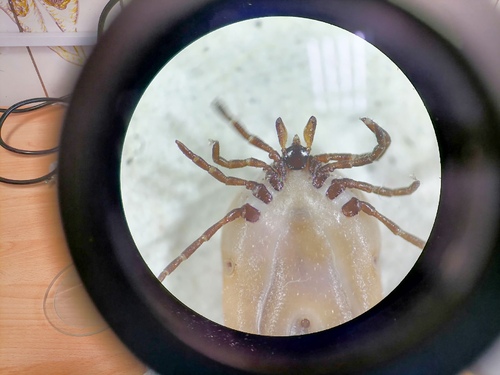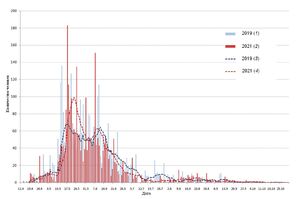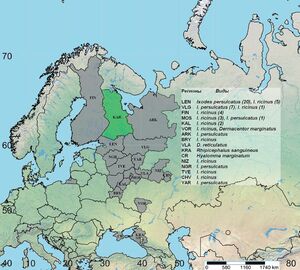– The testing protocol of the Center for Hygiene and Epidemiology does not include identification of ticks to species. To deal with this issue, we had to get involved in the process. Receiving ticks is often a continuous workflow that cannot be stopped or slowed down, because people want to get the result of the infection test as quickly as possible. As a result, all ticks passed through our hands: we quickly determined the species, sex and development phase of the tick under a binocular microscope and sent it on for further analysis, - said Sergey Bugmyrin, Head of the Laboratory of Plant and Animal Parasitology at the Institute of Biology KarRC RAS.
As a result, scientists managed to examine about 2.5 thousand ticks out of the 6.5 thousand received over two years by the Center for Hygiene and Epidemiology. This sample permitted drawing conclusions about the species composition and rates of infection of ticks with especially dangerous infections.
There is a total of about 700 species of ixodid ticks in the world, six of which occur in our region. Two species - the taiga tick Ixodes persulcatus and the castor bean tick Ixodes ricinus - have the highest medical implications because they attack humans and carry pathogens. In 2019 and 2021, 95% (2318) of the ticks examined were taiga ticks and 3% (123) were castor bean ticks. The activity of the former peaked in May-June, and the latter in August.
Ticks have been studied in Karelia since the 1940s. Scientists see two major trends: northwards and westwards expansion of the taiga tick distribution and a decline of the castor bean tick population.
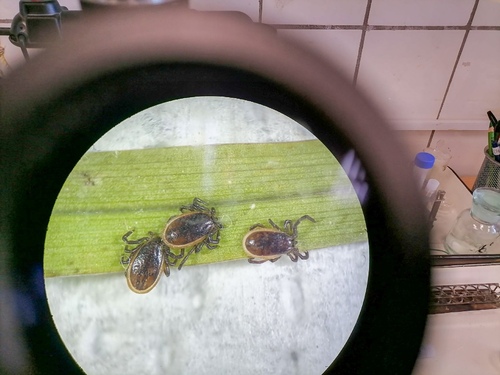
Ixodes persulcatus tick males. The infection rates in I. persulcatus are similar in males and females.
Males of the tick genus Ixodes are aphagous, but they may attach to a feeder for a short while,
which suffices for the tick-borne encephalitis virus to be passed on to a human
Taiga tick attacks at humans were most often registered in the central districts - Prionezhsky, Kondopozhsky, and Pryazhinsky. Northern districts produced single cases. For example, Louhsky and Kemsky districts are considered relatively safe: even if ticks are reported from there, they are most likely specimens brought in from elsewhere. The conditions in all districts further south are suitable for the existence of a local population of ticks.
Most specimens of the castor bean tick came from the Prionezhsky District, but the species is also found in the north and west of the republic, in particular, in the Lahdenpokhsky District.
Findings included also species that do not occur in Karelia (D. marginatus, D. reticulatus, H. marginatum, R. sanguineus). As a rule, they arrive attached to travellers from other regions or to their pets. Such cases accounted for 2% (55) of the total sample. Most of them come from the neighboring Leningrad and Vologda regions. The most distant point of attachment was Primorsky Krai.
The prevalence of the tick-borne encephalitis virus in taiga ticks was 1.5%. In the castor bean tick the virus has not been detected during the two years of the study. The rate of infection with borrelia of the B. burgdorferi s. l. complex was 32.5% in the taiga tick and 16.3% in the castor bean tick.
Interestingly, these figures differ from those scientists get by flagging in forest areas. E.g., data from a survey in the Gomselga village surroundings in Kondopozhsky District show the rate of infection with the virus of tick-borne encephalitis in ticks to be about 7%. The average rate of infection in ticks collected from vegetation in Karelia was about 4.4%.
– Our field studies mainly focus on the source area in Central Karelia, where the occurrence rate of tick-borne encephalitis is really high. The data obtained from the population are randomized and therefore more representative of the region as a whole, - Sergey Bugmyrin noted.
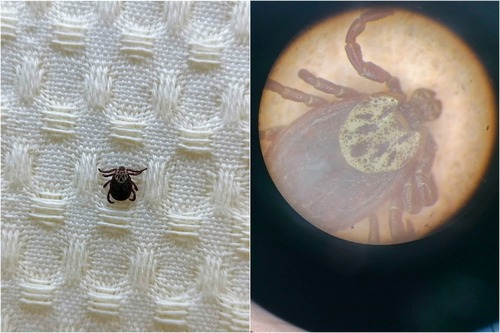
A female tick of the genus Dermacentor, brought into Karelia from the Voronezh Region
According to the State Report on the Environment, there were 11 registered cases of tick-borne encephalitis in Karelia in 2021, 15 cases in 2020, and 33 cases in 2019. The number of Lyme disease cases was 17 in 2021, 20 in 2020, and 46 in 2019.
– The taiga tick carries borrelia over 20 times more often than it carries tick-borne encephalitis. Yet, the number of Lyme disease cases is only one and a half that of encephalitis. Why such a difference? The thing is that the virus of tick-borne encephalitis is localized in the tick's salivary glands and is injected into the human bloodstream immediately after the skin is pierced. Borrelia, on the other hand, are usually localized in the intestines, and it takes a long attachment time for them to get into blood. That is, the fact that a tick carries Borrelia does not mean that the person will get sick. Removing the tick as soon as possible reduces the likelihood getting infected. Besides, people sometimes take a course of antibiotics after being bitten by a tick to be on the safe side, and thus avoid potential Lyme disease. Tick-borne encephalitis is a more dangerous disease, which almost always has pronounced symptoms, especially if a person is not vaccinated, - Sergey Bugmyrin commented.
The bacteria Ehrlichia muris and Anaplasma phagocytophillum, which cause monocytic ehrlichiosis and granulocytic anaplasmosis were detected in singular specimens of Karelian ticks. No cases of these infections in humans have been recorded.
Scientists plan to continue the collaboration with the Center for Hygiene and Epidemiology in the coming field season. As part of the project supported by a Russian Science Foundation grant, ticks will be tested for viruses not studied previously. With modern techniques, researchers can detect new infection agents and determine how dangerous they are for humans.
Photos by S. Bugmyrin / Institute of Biology KarRC RAS




